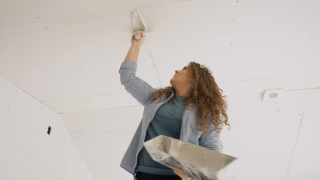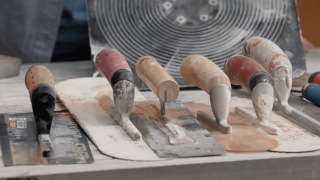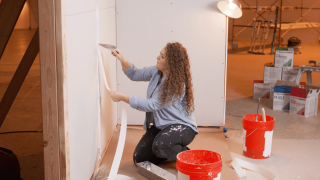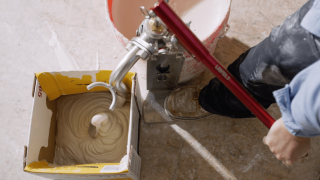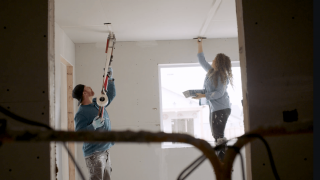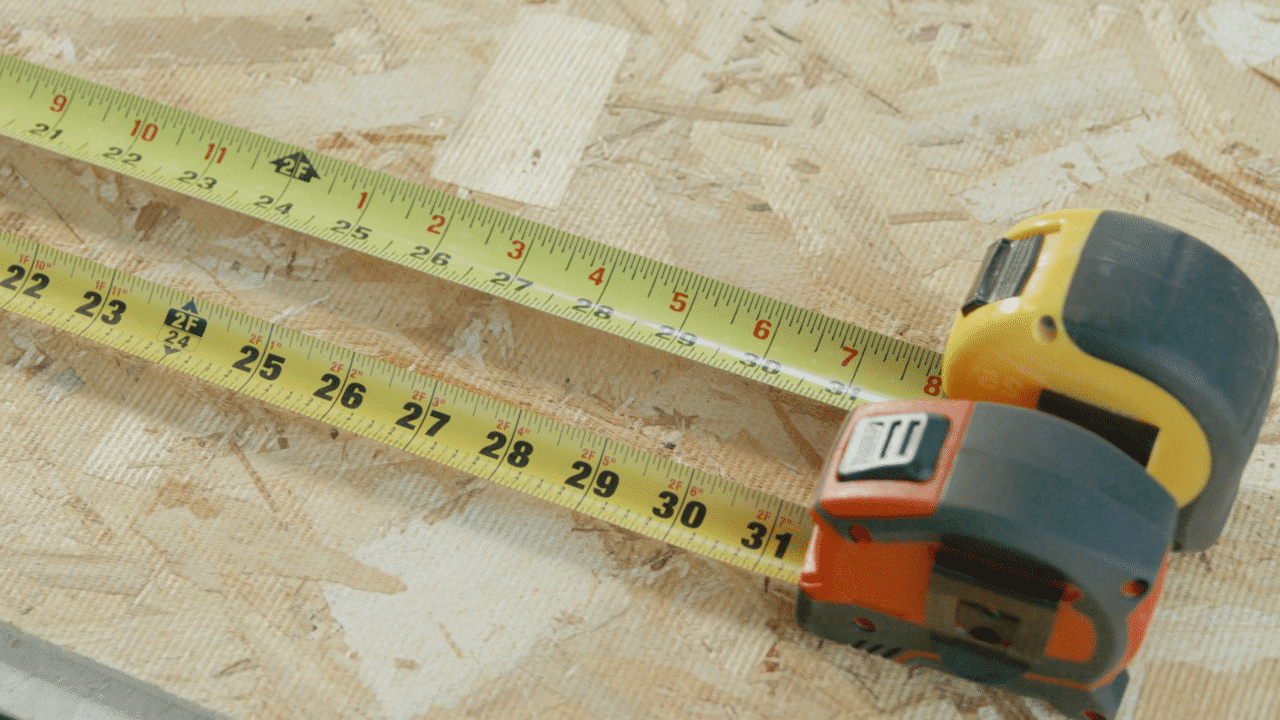
Whether you are doing general construction work, framing, or even finer work like finish carpentry, measuring tools are an essential part of your toolbox. But the tool you’ll reach for the most is the tape measure.
“If there’s one tool that you use all the time—every single day—as a contractor, it’s going to be the tape measure. When you measure a remodel and you’re giving a quote, you use a tape measure. When you’re cutting lumber, you use a tape measure. You use a tape measure for absolutely every part of the building process—from estimate all the way through the final punch list.” – Jordan Smith
When choosing a tape measure, there are some must-have features you should look for, but you’ll also need to consider your own preferences and job type.
5 Must-Have Tape Measure Features
Some tape measure features are non-negotiable, like a good standout length, solid body, and durable tape. Make sure that whatever tape measure you buy includes these essential features.
- At least 25 feet long: 25-foot tapes can do just about any job. Look for a tape that is at least this length if you are working in general construction. If you need to do long distance measurements, opt for an open reel style tape. For finish carpentry, 16 feet is typically plenty of length.
- Tough tape: The metal tape, also called the “blade,” is going to get heavy use—much more than it would at home for DIY projects—so it needs a tough coating. A mylar polyester film coating is fine (and often less expensive) but a nylon coating is better and will last much longer. If it doesn’t have any strength coating, don’t buy it.
- Standout: The further length of the tape can reach without breaking its straight line, the longer its standout. This means you can take more accurate measurements without needing someone on the other end. Wider blades will generally have a longer standout, while narrow blades will have a shorter standout and are better for smaller measurements.
- Durable case: It’s inevitable, you are going to drop your tape measure, possibly from a significant height. Get a tape whose case is built to be dropped.
- Easy to read: You should be able to see clear markings that allow you to take measurements down quickly and accurately. Tapes can come with double sided markings for easy reading, center marks, stud marks, or fractions of an inch marked for those who prefer the visual.
A tape measure is only one of the essential tools you’ll need on a construction site. Learn more about the most important construction tools—and how to use them safely—in MT Copeland’s online class, taught by professional builder and craftsman Jordan Smith.
The Top Three Best Tape Measures, According to Professional Builder Jordan Smith
The best tape measure for you will depend on a few personal preferences and the job type you do most frequently. Jordan’s top three tape measures have all of the non-negotiables and maintain their standing as industry favorites year after year.

Best for General Construction, With Auto Lock
The Stanley FatMax 30 is the modern classic professional’s tape measure. It’s a tougher version of the popular Stanley Powerlock but with a wider tape and therefore a larger standout. The auto lock feature means that the tape will automatically stay in place when extended without having to push any lock buttons.
Whether you are doing general construction work, framing, or even finer work like finish carpentry, measuring tools are an essential part of your toolbox. But the tool you’ll reach for the most is the tape measure.
“If there’s one tool that you use all the time—every single day—as a contractor, it’s going to be the tape measure. When you measure a remodel and you’re giving a quote, you use a tape measure. When you’re cutting lumber, you use a tape measure. You use a tape measure for absolutely every part of the building process—from estimate all the way through the final punch list.” – Jordan Smith
When choosing a tape measure, there are some must-have features you should look for, but you’ll also need to consider your own preferences and job type.
5 Must-Have Tape Measure Features
Some tape measure features are non-negotiable, like a good standout length, solid body, and durable tape. Make sure that whatever tape measure you buy includes these essential features.
- At least 25 feet long: 25-foot tapes can do just about any job. Look for a tape that is at least this length if you are working in general construction. If you need to do long distance measurements, opt for an open reel style tape. For finish carpentry, 16 feet is typically plenty of length.
- Tough tape: The metal tape, also called the “blade,” is going to get heavy use—much more than it would at home for DIY projects—so it needs a tough coating. A mylar polyester film coating is fine (and often less expensive) but a nylon coating is better and will last much longer. If it doesn’t have any strength coating, don’t buy it.
- Standout: The further length of the tape can reach without breaking its straight line, the longer its standout. This means you can take more accurate measurements without needing someone on the other end. Wider blades will generally have a longer standout, while narrow blades will have a shorter standout and are better for smaller measurements.
- Durable case: It’s inevitable, you are going to drop your tape measure, possibly from a significant height. Get a tape whose case is built to be dropped.
- Easy to read: You should be able to see clear markings that allow you to take measurements down quickly and accurately. Tapes can come with double sided markings for easy reading, center marks, stud marks, or fractions of an inch marked for those who prefer the visual.
A tape measure is only one of the essential tools you’ll need on a construction site. Learn more about the most important construction tools—and how to use them safely—in MT Copeland’s online class, taught by professional builder and craftsman Jordan Smith.
The Top Three Best Tape Measures, According to Professional Builder Jordan Smith
The best tape measure for you will depend on a few personal preferences and the job type you do most frequently. Jordan’s top three tape measures have all of the non-negotiables and maintain their standing as industry favorites year after year.

Best for General Construction, With Auto Lock
The Stanley FatMax 30 is the modern classic professional’s tape measure. It’s a tougher version of the popular Stanley Powerlock but with a wider tape and therefore a larger standout. The auto lock feature means that the tape will automatically stay in place when extended without having to push any lock buttons.
- Autolocking
- 14′ standout
- BladeArmor coating
- Extended pull tab extension for better grip when working alone
- Non-slip rubber bottom for easy layouts
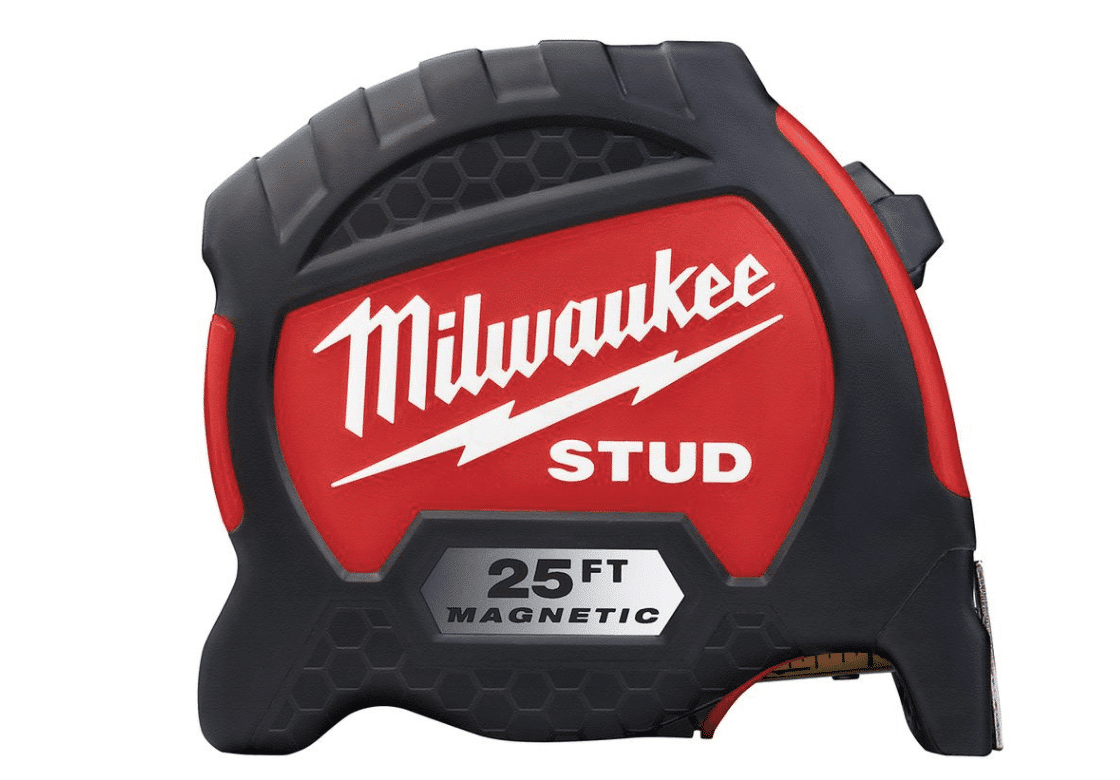
Best for Framing and General Construction
The Milwaukee STUD has all of the features of the Stanley FatMax but without the auto lock. Many builders (including Jordan) prefer to regulate the extension and recoil of the tape with their finger for extra quick movement. Also an industry standby, it is slightly lighter than the Stanley and has a competitive standout.
- 17′ standout
- Measurements on both sides of tape
- Marking for common framing measurements
- Nylon wrapped blade (both sides)
- Finger guard for retracting
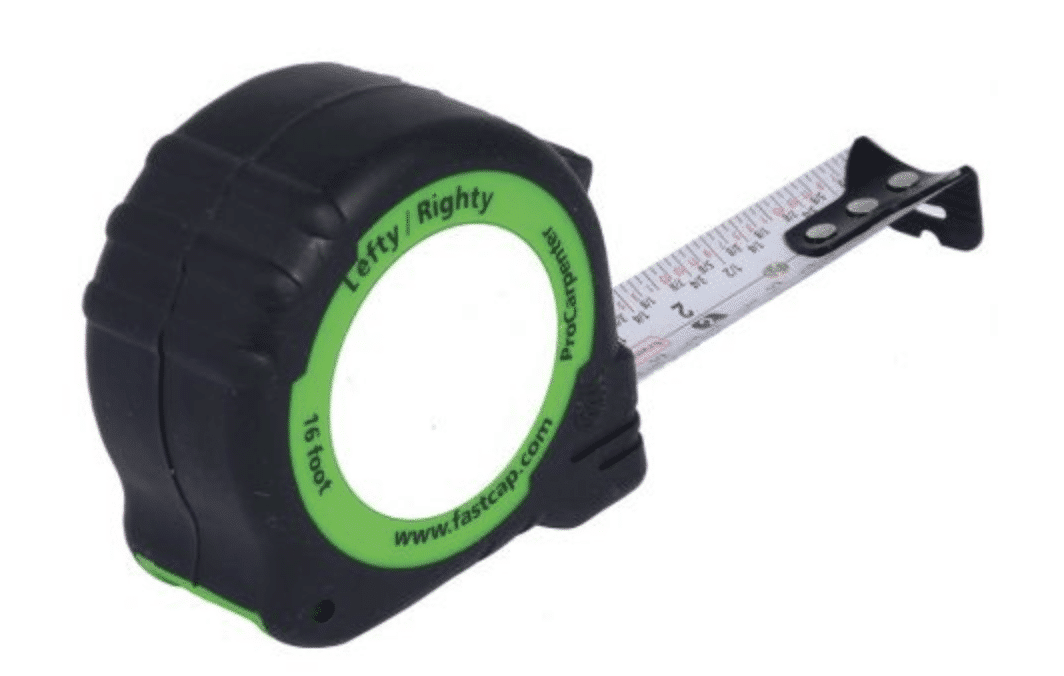
Best for Carpentry
The FastCap ProCarpenter is a tape measure designed with finish carpenters in mind who are often taking small measurements that must be exact. It is customizable for reading preferences including reverse reading (readable on either side of the tape from right and left), an area to take notes directly on the tape, metric options (including reverse reading), and even metric and standard combo tapes. Features include:
- Speedclip style belt clip for quick removal
- Built in pencil sharpener and erasable notepad
- High-contrast tape for easy reading
- Compact design, easy to carry, lighter than general construction tape measures
Optional Features for Your Tape Measure
While a standard tape measure is a great tool, you’ll get the most out of your tape measure by choosing one that is made for the way you work. Different types of lock mechanisms, fractional read tapes, or specialty left-handed tapes are all optional ways to customize your tape measure to the way you work.
- Automatic locking is great for working alone and precise measuring, but many builders prefer to use their finger to control the tape so that they aren’t constantly pushing the unlock button—a personal preference that is up to you!
- Magnetic tapes (either the base or the pull tab) can help with stability and grabbing onto metal surfaces during measuring. Note: A magnetic tape measure ends up sticking to everything metal so they are not recommended for construction sites where they will pick up debris.
- Oversized pull tabs can help you more easily grip onto edges while working alone.
- If you aren’t yet comfortable reading the markings on a tape measure or don’t want to do the math in your head, fractional read tapes are easier to read.
- Many tapes can be special ordered for either right or left handed users so that you aren’t reading the numbers upside down. There are also tapes that come with both sides marked, like the Milwaukee STUD.
Tips for Using Your Tape Measure
- Learn how to read a tape measure from the anatomy of a tape measure to the Imperial measurements indicated by each mark.
- To measure a length as exactly as possible for detailed finishing work or expensive materials where you really only have one shot to get it right, try the “burning an inch” method.
- If you prefer to keep your tape measure in a holster, remove the belt clip so that the tape measure is easier to take in and out of your holster.
- If you are measuring alone, tap a nail into the outside edge of the surface and use the hole in the pull tab to anchor the tape to the surface before taking your measurement.
- In a pinch, you can use your tape measure as a straight edge if the mark doesn’t need to be 100% accurate.
More Toolbox Recommendations
Get Jordan’s complete class on choosing and using essential construction tools in MT Copeland’s Hand Tools online course.
MT Copeland offers video-based online classes that give you a foundation in construction fundamentals with real-world applications. Classes include professionally produced videos taught by practicing craftspeople, and supplementary downloads like quizzes, blueprints, and other materials to help you master the skills.



